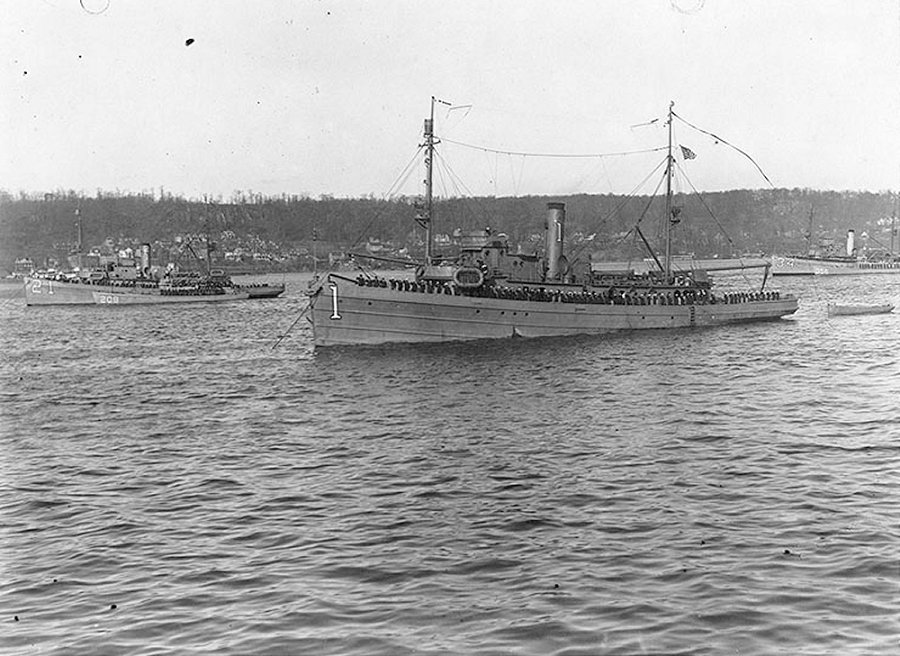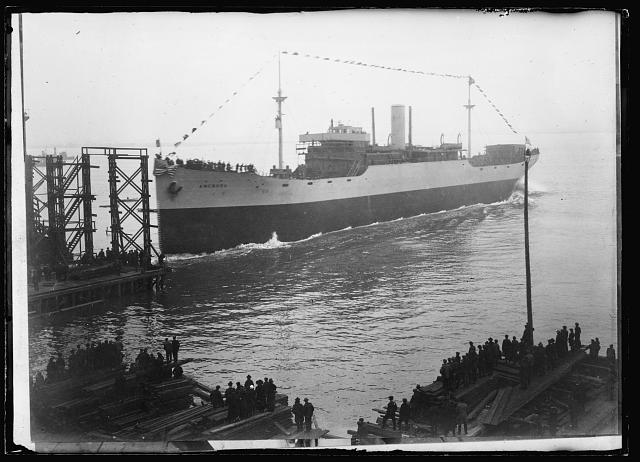|
Lapwing-class Minesweeper
The ''Lapwing''-class minesweeper, often called the Bird class, was an early "AM-type" oceangoing minesweeper of the United States Navy. Seven ships of the class were commissioned during World War I, and served well into the 1950s. A number were refitted to serve as ocean-going tugs, salvage vessels, seaplane tenders, or submarine rescue ships. The propulsion system consisted of 2 Babcock & Wilcox 200psi boilers and a 1,400shp Harlan and Hollingsworth Harlan & Hollingsworth was a Wilmington, Delaware, firm that constructed ships and railroad cars during the 19th century and into the 20th century. Founding Mahlon Betts, a carpenter, arrived in Wilmington in 1812. After helping construct many ... triple expansion reciprocating steam engine. Ships The table makes no distinction between classification as "Minesweeper No. X" and "AM-X". This change affected all boats equally ca. 1920. All boats reclassified as Fleet Tugs (AT) where later again reclassified as Fleet Tug, Old ... [...More Info...] [...Related Items...] OR: [Wikipedia] [Google] [Baidu] |
USS Tanager (AM-5)
USS ''Tanager'' (AM-5) was an acquired by the U.S. Navy for the dangerous task of removing mines from minefields laid in the water to prevent ships from passing. ''Tanager'' was named by the U.S. Navy after the tanager, one of numerous American passerine birds. ''Tanager'' (Minesweeper No. 5) was laid down on 28 September 1917 at New York City, by the Staten Island Shipbuilding Co.; launched on 2 March 1918; sponsored by Mrs. G. H. Bates; and commissioned on 28 June 1918. World War I Atlantic operations After operating locally out of Boston, Massachusetts through the late summer of 1918, ''Tanager'', in company with ''Western King'', departed New London, Connecticut, on 26 September 1918, bound for the Azores. The minesweeper subsequently operated out of Punta Delgada on local escort duties with the Azores detachment through the fall, before pushing on toward Portugal and reaching Lisbon on the day after Christmas 1918. Later in her tour in European waters, she delivered ... [...More Info...] [...Related Items...] OR: [Wikipedia] [Google] [Baidu] |
USS Eider (AM-17)
USS ''Eider'' (AM-17) was a of the United States Navy. Laid down on 25 September 1917 by the Pusey and Jones Company of Wilmington, Delaware, ''Eider'' was launched on 26 May 1918, and commissioned as USS ''Eider'', (Minesweeper No.17) on 23 January 1919. Post-World War I Operations ''Eider'' sailed out of Philadelphia, Pennsylvania, for minesweeping operations in the Delaware River approaches until 8 March 1919, then put into Norfolk, Virginia, to prepare for distant service. On 3 April 1919 she departed for Scotland and alternately based on Kirkwall and Invergordon, Orkney Islands, swept the vast North Sea minefield. ''Eider'' was on hand to assist in the rescue of when ''Pelican'' was gravely damaged by an exploding mine on 9 July 1919. Returning home in October she called at Brest, Lisbon, the Azores and Bermuda. Arriving at Charleston Navy Yard on 1 December 1919 ''Eider'' was placed in reduced commission for repairs. On 29 May 1920 she joined in salvage operations ... [...More Info...] [...Related Items...] OR: [Wikipedia] [Google] [Baidu] |
USS Partridge (AM-16)
USS ''Partridge'' (AM-16) was an acquired by the United States Navy for the dangerous task of removing mines from minefields laid in the water to prevent ships from passing. ''Partridge'' was named after the partridge, any of various gallinaceous birds, such as the ruffed grouse or bob-white quail, found in North America. ''Partridge'' was laid down on 14 May 1918 by the Chester Shipbuilding Co., Chester, Pennsylvania: launched on 15 October 1918; sponsored by Ms. C. H. McCay; and commissioned on 17 June 1919. Post-World War I operations Completed too late to participate in World War I, ''Partridge'' operated in the Pacific Ocean until returning to the Atlantic Ocean in June 1941. Converted to an ocean-going tug, ''Partridge'' was reclassified AT-138 on 1 June 1942. The tug participated in rescue and towing duties along the eastern seaboard and in the Caribbean, making an important contribution to saving lives and ships, until early May 1944. World War II operations Re ... [...More Info...] [...Related Items...] OR: [Wikipedia] [Google] [Baidu] |
USS Quail (AM-15)
USS ''Quail'' (AM-15) was a U.S. Navy , named after the quail, a migratory game bird. It was laid down 14 May 1918 by the Chester Shipbuilding Co., Chester, Pennsylvania; launched 6 October 1918; and commissioned 29 April 1919. Post-World War I operations ''Quail'' steamed to Kirkwall, Scotland, to join the North Sea Mine Sweeping Detachment. She operated with this force clearing the North Sea of mines until 25 November 1919. She operated with the Atlantic Fleet in Cuban waters during early 1920, and then along the U.S. East Coast. In September 1922 she was attached to the submarine base at Coco Solo, Panama Canal Zone, operating in the Caribbean. ''Quail'' made a cruise to the east coast in late 1923, and in 1925 she was at Philadelphia, Pennsylvania, for repairs. In 1927 she spent time patrolling the west coast of Nicaragua, and later joined the fleet in the Caribbean for maneuvers. From July 1928 to January 1929, she was on the east coast, operating between Virg ... [...More Info...] [...Related Items...] OR: [Wikipedia] [Google] [Baidu] |
USS Woodcock (AM-14)
USS ''Woodcock'' (AM-14) was an acquired by the United States Navy for the dangerous task of removing mines from minefields laid in the water to prevent ships from passing. ''Woodcock'' was named, by the U.S. Navy, for the woodcock, a game bird that frequents wooded areas. ''Woodcock'' (Minesweeper No. 14) was laid down on 19 October 1917 at Chester, Pennsylvania, by the Chester Shipbuilding Co.; launched on 12 May 1918; sponsored by Mrs. Lewis T. Kniskern; and commissioned at the Philadelphia Navy Yard on 19 February 1919. World War I Atlantic operations After performing experimental minesweeping work at Newport, Rhode Island, and tending lightships at New York, ''Woodcock'' sailed for the Orkney Islands and reached Kirkwall, Scotland, on 10 July 1919. Over the ensuing months, the ship operated in the North Sea on mine-sweeping duties with the Atlantic Fleet's minesweeping detachment. During that time, ''Woodcock'' spent 54 days in the minefields and 28 in port for neede ... [...More Info...] [...Related Items...] OR: [Wikipedia] [Google] [Baidu] |
Merchant Shipbuilding Corporation
The Merchant Shipbuilding Corporation (abbreviated MSC) was an American corporation established in 1917 by railroad heir W. Averell Harriman to build merchant ships for the Allied war effort in World War I. The MSC operated two shipyards: the former shipyard of John Roach & Sons at Chester, Pennsylvania, and a second, newly established emergency yard at Bristol, Pennsylvania, operated by the MSC on behalf of the U.S. Shipping Board's Emergency Fleet Corporation (EFC). MSC completed only four ships before the war's end. However, both the U.S. Shipping Board and Harriman himself anticipated a shipbuilding boom in the postwar period, and consequently MSC continued to work on its wartime contracts, eventually building some 81 ships, including not only the USSB vessels but also four minesweepers for the U.S. Navy, a number of oil tankers for private companies, and four passenger liners Harriman built for his own shipping lines. Both Harriman and the USSB were completely incorrect in ... [...More Info...] [...Related Items...] OR: [Wikipedia] [Google] [Baidu] |
USS Turkey (AM-13)
USS ''Turkey'' (AM-13) was a the U.S. Navy, thus named after the bird, not after the country which in 1917 was an enemy in the ongoing World War I. The minesweeper was acquired by for the dangerous task of removing mines from minefields laid in the water to prevent ships from passing. ''Turkey'' (Minesweeper No. 13) was laid down on 19 August 1917 at Chester, Pennsylvania, by the Chester Shipbuilding Co.; launched on 30 April 1918; sponsored by Mrs. W. T. Smith; and commissioned on 13 December 1918. Clearance of World War I mines Although completed too late to see service during World War I, ''Turkey'' took part in the gigantic operation to clear the mine barrage which had been laid in the North Sea during this conflict. This system of minefields constituted a formidable obstacle to the resumption of trade in the aftermath of the war. After steaming across the Atlantic Ocean, the new minesweeper arrived at Kirkwall, Scotland, on 20 April 1919 and joined the American forces ... [...More Info...] [...Related Items...] OR: [Wikipedia] [Google] [Baidu] |

